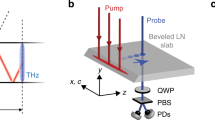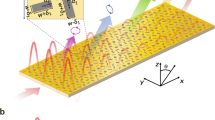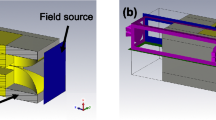Abstract
The idea of using radiation in the 0.1–1.0 THz range as carrier waves for free-space wireless communications has attracted growing interest in recent years, due to the promise of the large available bandwidth1,2. Recent research has focused on system demonstrations3,4, as well as the exploration of new components for modulation5, beam steering6 and polarization control7. However, the multiplexing and demultiplexing of terahertz signals remains an unaddressed challenge, despite the importance of such capabilities for broadband networks. Using a leaky-wave antenna based on a metal parallel-plate waveguide, we demonstrate frequency-division multiplexing and demultiplexing over more than one octave of bandwidth. We show that this device architecture offers a unique method for controlling the spectrum allocation, by variation of the waveguide plate separation. This strategy, which is distinct from those previously employed in either the microwave8 or optical9 regimes, enables independent control of both the centre frequency and bandwidth of multiplexed terahertz channels.
This is a preview of subscription content, access via your institution
Access options
Subscribe to this journal
Receive 12 print issues and online access
$209.00 per year
only $17.42 per issue
Buy this article
- Purchase on Springer Link
- Instant access to full article PDF
Prices may be subject to local taxes which are calculated during checkout





Similar content being viewed by others
References
Piesiewicz, R. et al. Short-range ultra broadband terahertz communications: concepts and perspectives. IEEE Antennas Propag. Mag. 49, 24–39 (2007).
Kleine-Ostmann, T. & Nagatsuma, T. A review on terahertz communications research. J. Infrared Milli. Terahertz Waves 32, 143–171 (2011).
Song, H.-J. et al. 24 Gbit/s data transmission in 300 GHz band for future terahertz communications. Electron. Lett. 48, 953–954 (2012).
Koenig, S. et al. Wireless sub-THz communication system with high data rate. Nature Photon. 7, 977–981 (2013).
Chen, H.-T. et al. Active terahertz metamaterial devices. Nature 444, 597–600 (2006).
Monnai, Y. et al. Terahertz beam steering and variable focusing using programmable diffraction gratings. Opt. Express 21, 2347–2354 (2013).
Shuvaev, A. et al. Electric field control of terahertz polarization in a multiferroic manganite with electromagnons. Phys. Rev. Lett. 111, 227201 (2013).
Oliner, A. A. & Jackson, D. R. in Antenna Engineering Handbook (ed. Volakis, J. L.) Ch. 11 (McGraw-Hill, 2007).
Keiser, G. Optical Fiber Communications 4th edn (McGraw-Hill, 2011).
Yan, Y. et al. High-capacity millimetre-wave communications with orbital angular momentum multiplexing. Nature Commun. 5, 4876 (2014).
Luo, L.-W. et al. WDM-compatible mode-division multiplexing on a silicon chip. Nature Commun. 5, 3069 (2014).
Acampora, A. S. An Introduction to Broadband Networks (Plenum, 1994).
Su, K., Moeller, L., Barat, R. B. & Federici, J. F. Experimental comparison of performance degradation from terahertz and infrared wireless links in fog. J. Opt. Soc. Am. A 29, 179–184 (2012).
Suen, J. Y., Fang, M. T. & Lubin, P. M. Global distribution of water vapor and cloud cover—sites for high-performance THz applications. IEEE Trans. THz Sci. Technol. 4, 86–100 (2014).
Sabharwal, A., Khoshnevis, A. & Knightly, E. Opportunistic spectral usage: bounds and a multi-band CSMA/CA protocol. IEEE/ACM Trans. Netw. 15, 533–545 (2007).
Monnai, Y. et al. Terahertz beam focusing based on plasmonic waveguide scattering. Appl. Phys. Lett. 101, 015116 (2012).
Hon, P. W. C., Liu, Z., Itoh, T. & Williams, B. S. Leaky and bound modes in terahertz metasurfaces made of transmission-line metamaterials. J. Appl. Phys. 113, 033105 (2013).
Esquius-Morote, M., Gomez-Diaz, J. S. & Perruisseau-Carrier, J. Sinusoidally modulated graphene leaky-wave antenna for electronic beam scanning at THz. IEEE Trans. THz Sci. Technol. 4, 116–122 (2014).
Mendis, R. & Grischkowsky, D. Undistorted guided-wave propagation of subpicosecond terahertz pulses. Opt. Lett. 26, 846–848 (2001).
Keshavamurthy, T. L. & Butler, C. M. Characteristics of a slotted parallel-plate waveguide filled with a truncated dielectric. IEEE Trans. Antennas Propag. 29, 112–117 (1981).
Chuang, C. W. Generalized admittance matrix for a slotted parallel-plate waveguide. IEEE Trans. Antennas Propag. 36, 1227–1230 (1988).
Lee, C. -W. & Son, H. Periodically slotted dielectrically filled parallel-plate waveguide as a leaky-wave antenna: E-polarization case. IEEE Trans. Antennas Propag. 47, 171–178 (1999).
Lee, J.-I., Cho, U.-H. & Cho, Y.-K. Analysis for a dielectrically filled parallel-plate waveguide with finite number of periodic slots in its upper wall as a leaky-wave antenna. IEEE Trans. Antennas Propag. 47, 701–706 (1999).
Mendis, R. & Mittleman, D. M. A 2D artificial dielectric with 0 < n < 1 for the terahertz region. IEEE Trans. Microw. Theory Techn. 58, 1993–1998 (2010).
Mendis, R., Liu, J. & Mittleman, D. M. THz mirage: deflecting terahertz beams in an inhomogeneous artificial dielectric based on a parallel-plate waveguide. Appl. Phys. Lett. 101, 111108 (2012).
Liu, J., Mendis, R. & Mittleman, D. M. A Maxwell's fish eye lens for the terahertz region. Appl. Phys. Lett. 103, 031104 (2013).
Mbonye, M., Mendis, R. & Mittleman, D. M. Inhibiting the TE1-mode diffraction losses in terahertz parallel-plate waveguides using concave plates. Opt. Express 20, 27800–27809 (2012).
Mbonye, M., Mendis, R. & Mittleman, D. M. Measuring TE1 mode losses in terahertz parallel-plate waveguides. J. Infrared Milli. Terahertz Waves 34, 416–422 (2013).
Mendis, R. & Mittleman, D. M. Comparison of the lowest-order transverse-electric (TE1) and transverse-magnetic (TEM) modes of the parallel-plate waveguide for terahertz pulse applications. Opt. Express 17, 14839–14850 (2009).
Mendis, R. & Mittleman, D. M. An investigation of the lowest-order transverse-electric (TE1) mode of the parallel-plate waveguide for THz pulse propagation. J. Opt. Soc. Am. B 26, 6–13 (2009).
Acknowledgements
The authors thank K. Reichel for contributions. This work was supported by the US National Science Foundation and the W.M. Keck Foundation.
Author information
Authors and Affiliations
Contributions
All of the authors contributed to the conception and design of these experiments. R.W.M. and N.J.K. built the set-up and collected and analysed the data. All authors contributed to the discussions and to the writing of the manuscript.
Corresponding author
Ethics declarations
Competing interests
The authors declare no competing financial interests.
Supplementary information
Supplementary information
Supplementary information (PDF 385 kb)
Rights and permissions
About this article
Cite this article
Karl, N., McKinney, R., Monnai, Y. et al. Frequency-division multiplexing in the terahertz range using a leaky-wave antenna. Nature Photon 9, 717–720 (2015). https://doi.org/10.1038/nphoton.2015.176
Received:
Accepted:
Published:
Issue Date:
DOI: https://doi.org/10.1038/nphoton.2015.176
This article is cited by
-
Conformal leaky-wave antennas for wireless terahertz communications
Communications Engineering (2023)
-
Terahertz dual-beam leaky-wave antenna based on composite spoof surface plasmon waveguide
Optoelectronics Letters (2023)
-
Terahertz Beam Steering: from Fundamentals to Applications
Journal of Infrared, Millimeter, and Terahertz Waves (2023)
-
The effect of angular dispersion on THz data transmission
Scientific Reports (2022)
-
Versatile metal-wire waveguides for broadband terahertz signal processing and multiplexing
Nature Communications (2022)



